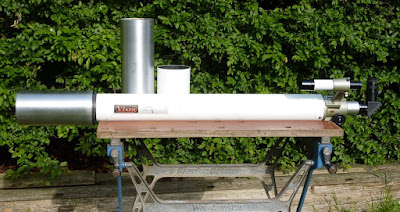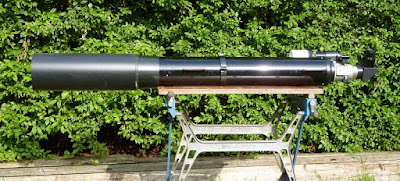*

My little Vixen 90M 90mm F/11 achromatic refractor had proven to be rather prone to dewing of the objective under certain observing conditions. Then I realized that I had been hoarding a length of 100mm diameter, thin aluminium tube amongst my collection of potentially useful materials. This tubing fitted only slightly loosely on the front stub of the Vixen objective cell. A turn of electrical tape was all that was required to provide a nice sliding fit. The original Vixen dewshield had soft ribbon as 'packing' glued on the inside at one end to avoid scratching the cell's paint finish.
It took a while working in the lathe, with a wooden plug for the tailstock end, to remove years of weathering from the exterior surface. After using coarse abrasive paper to cut down to bare metal I finished off with steel wool and then a scrap of Scotch-Brite fine abrasive fiber to get a fair finish. The finish is certainly not perfect but it will serve its purpose in the pitch dark, in the privacy of my secluded, rural garden.

For the new dewshield, I used an old fashioned or "classic" 2.5 x D multiplier instead of the Vixen original's 1.5 to provide extra length. Most modern refractors, and APOs in particular, use the shorter 1.5 x aperture dewshield length to give a stumpy look and to emphasize their already short focal length. And, no doubt, to provide greater portability and reduced storage requirements. Some dewshields are retractable or even reversible to further reduce the length of the instrument's storage case or bag.
On the Vixen I had always felt slightly cheated because the original dewshield looked rather too mean to my eyes on an F/11 OTA. Not quite a "classic" F15 refractor but definitely looming towards it.
Note how much of the original dewshield length is already "lost" on the 52mm long, extended front of the protruding objective cell beyond the dewshield's supporting ring. A real cynic might argue that the strangely distorted form of the objective cell is a cynical marketing ploy, by Vixen, to pretend that the M90 is a shorter focus instrument or even a semi-APO. The cost of such a deep casting, merely to hide the true [effective] length of the instrument must considerably outweigh the cost of 2" greater length of main tube material!

Choosing the visual balance between "nose heavy" dewshield lengths and long thin main tubes must be a difficult one [a nightmare?] for refractor manufacturers these days. They must cater for all of those who are buying an instrument entirely on appearance alone. Most of whom aspire to an "exotic" APO rather than the classical, long focus refractor. A long, skinny main tube now looks slightly old fashioned despite the optical and practical benefits of owning a long focus instrument. An achromat wants to be as long as reasonably possible to minimise false colour and allow for comfortably long eye-relief eyepieces.

The unused effective length of the Vixen dewshield certainly did not help it to resist dewing! In fact I could have made the new dewshield even longer to allow for the 2" of wasted length lying over the extended cell. I wish I'd thought of it at the time. Though I do have a slightly rougher length of tubing left to play with if I get really desperate. See later added images for a 2.5 x aperture dewshield allowing an extra 5cm for the objective cell, forward extension. I think the [unadjusted] 2.5D dewshield probably looks best on this particular F:11 90mm Vixen refractor. A longer F:15 would probably benefit from a compensated 2.5D dewshield to remain in scale.

For my equally dew-prone, 150mm F:8 refractor I have a nice long, "memory-plastic" tube to slide over the original and ridiculously short dewshield. This thin, but stiff, black plastic came in an inexpensive, pre-curved roll intended for some gardening purpose which I have now long forgotten. Its natural tendency to curve tightly to rather a small cylinder avoids sloppiness or the need for ugly clips or clamps in use. If this plastic was sold by telescopes dealers, as dewshield extensions, it would probably cost £100 instead of mere pocket change. Note the ludicrous scale of a 2.5D, 47cm long, dewshield on such a short focus F:8 6" refractor. It is no wonder they cheated on dewshield length!
I really need to clean the Vixen objective lens while I have the cell unscrewed from the main tube. [Separating the cell from the main tube for the first time is a whole story in itself!] BTW: What looks like a rather shiny flange is actually the female thread where the cell screws onto the main tube.
After removing the securing rings I
lifted the glass doublet by gently lowering the cell over a short length well-padded tube or stand. Those who haven't learned this trick will probably just tip the cell upside down only to find the glass stuck fast. Or will drop the objective glass right onto the floor!
The close fit allows the glass to tilt against the inner cell wall causing it to jam. While standing a stable length of tube upright on the bench, with a few layers of tissue on top, ensures the amateur can safely lift the glass objective free of the cell without tilting. Even a drinking glass will do as a lens removal stand provided it is padded to avoid scratching the delicate lens coatings.
I used a rubber bulb, lens blower to remove any accumulated dust before gently using lens cleaner on the objective with lens tissue. As is typical for any lens over about 75mm the glass elements are not cemented. So great care will be required to avoid them sliding apart once they are no longer co-located by the objective cell.
The Vixen, like my other refractors, is always stored upright, on its "nose." [Dewshields resting on the floor.] However, the focuser is not remotely air or dust tight even with an eyepiece, star diagonal or sealing plug in place. So the back, as well as the front of the objective, slowly gathers dirt over the years. Anybody with a functioning memory would probably remember to drop a loose plastic bag over the focusers after use, but there we are.
It has been said that a cloth bag over an empty focuser is better. Since this allow the OTA to breathe with changing humidity and temperature. A plastic bag or sealed container of any kind will trap moisture inside the OTA. Putting away a soaking wet instrument is asking for trouble. The moisture is trapped and may eventually attack the lens coatings. Long term storage ought to be indoors where humidity is much lower than an unheated shed or garage. Capping an objective while still wet with dew is also unwise. The irony is that bringing a cold instrument indoors will provide a thick layer of dew. This must be allowed to evaporate by itself on the lens. Wiping it dry is prone to damage the lens surface.
I have lined the longer Vixen dewshield tube with thin, matt black, "
Funky Foam" to kill reflections and reduce thermal cooling effects. Most objects radiate their warmth to the night sky. This can even super-cool an instrument below ambient temperature.
It is interesting how the semi-polished alloy dewshield tube looks smaller in diameter than the white painted original. At least it does in the top picture. Yet they are identical in size apart from their length. I'll probably not bother with priming and spraying the new dewshield white to match the main tube.
Click on any image for an enlargement.
*
 Running Gui_Plop software for a 250mm x 40mm mirror with 3, 6, 9 and 18 point support produced the following:
Running Gui_Plop software for a 250mm x 40mm mirror with 3, 6, 9 and 18 point support produced the following:  The columns of figures alongside show the actual deviation from perfect support in figures
The columns of figures alongside show the actual deviation from perfect support in figures  9 point RMS = 6.475 ^ -07
9 point RMS = 6.475 ^ -07
 Here is an 18 point cell from JMI. Chosen for the clarity of the website image. 6 triangles are balanced on three see-saw bars.[Whiffletrees] So that all support points are pivoted to share the applied loads evenly. The mirror blank usually rests on slippery plastic "buttons" to avoid stiction. Such complexity is usually reserved for larger and thinner mirrors.
Here is an 18 point cell from JMI. Chosen for the clarity of the website image. 6 triangles are balanced on three see-saw bars.[Whiffletrees] So that all support points are pivoted to share the applied loads evenly. The mirror blank usually rests on slippery plastic "buttons" to avoid stiction. Such complexity is usually reserved for larger and thinner mirrors.












